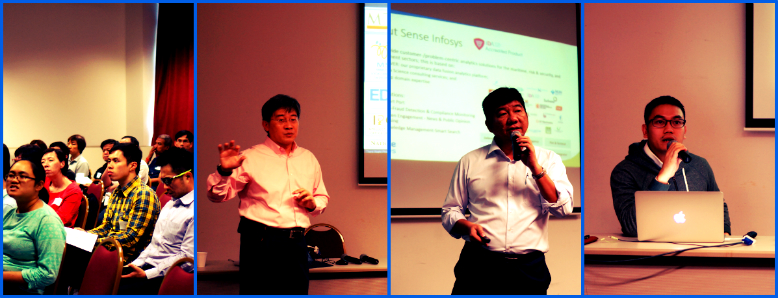Make innovative leaps by harnessing data

In this day and age, when the Internet of Things and cloud storage systems are taken for granted, it is incredible that we all still depend heavily on a service as outdated as email.
The pain of going through dozens of email threads and messages for a single crucial Word document is shared by many of us. This problem only gets worse if you receive hundreds of emails a day.
(And good luck if you get someone who sends email instructions one sentence at a time!)
Services like Slack, a cloud-based internal communications and collaboration platform, have attempted to help companies become a little bit smarter about how they work together, so that the number of unnecessary emails is kept to a minimum.
Facebook is also jumping on the corporate intelligence bandwagon with its hot new Facebook at Work platform.
But why not take things a little further, and incorporate a little intelligence into our workflows?
That kind of thinking inspired Third Sight, which was featured at the recent InnoLeap Sharing Day, a programme by the Government Technology Agency Singapore,on 23 September 2016.
InnoLeap Sharing Day seeks to raise awareness of technologies, and facilitate the exchange of business needs and technology ideas between government agencies and technology companies.
During the session, three promising tech companies under the Accreditation@IMDA programme showcased their products — in the fields of enterprise network analysis and enterprise content management — to officers from 18 government agencies.
Accreditation@IMDA helps the growth of promising start-ups by helping them to establish their track records and credibility, and also by providing opportunities to showcase their solutions to government buyers and large enterprises.
Excavating for Emails
Say you have been receiving several emails from various colleagues on budget discussions. How do you pull them all together?
“With Third Sight, you can right-click and view a file’s context: ‘This file was sent by so-and-so’, and tagged with a Budget label,” said Dr Tan Eng Siong, the CEO of Third Sight Pte Ltd. “You don’t need to do anything to the existing files, no specific naming conventions or anything like that. Just file one email, and the system does it for you.”
Dr Tan added that as people collaborate to make edits on files or documents, it can be a hassle to track different versions that are ping-ponged around in emails, just to verify when and how various important decisions were made. Third Sight will flag documents that have been edited in the days since you last logged in, he explained.
The platform even works with Google Search—documents that show up in Google will display a Third Sight icon if they have a tracked history within your company.
“Today, files are treated as pieces of data. But when you build up your ‘corporate memory’, it’s not just about the file, but who is associated with it: the what, how, and who,” noted Dr Tan. “Content as data is old thinking. We are promoting content as part of a knowledge network.”
Harnessing data to improve company-wide efficiency is one thing. How about on a national level?
For issues that are of interest to the average Singaporean, Sense Infosys’ Klaver solution collects the volumes and volumes of data available from multiple sources—mobile phones, sensors and social media networks, to name a few—and makes sense of it all, said Mr Stephen Chow, CEO of Sense Infosys..
Data such as Twitter mentions, news reports and surveys go in one end of the data fusion and analytics platform, and out the other, comes a coherent knowledge base, conveniently marked out in charts and graphs.
“This is particularly useful for campaign monitoring, for example,” he said.
This innovative system addresses the problem of citizen engagement for government agencies that play a role in public policy formulation and planning.
With a comprehensive understanding of all the information floating around out there, planners can get the whole picture of citizens’ sentiments, from across multiple disparate sources, without the need to be data analysts themselves, Mr Chow explained.
Handshaking Out Degrees of Separation
Indeed, corporate intelligence products have been revolutionising how large government agencies work, reducing processes that waste time and resources.
Here, the Handshakes dynamic mapping platform helps improve productivity through visualisation of data, according to Mr Daryl Neo, Co-Founder of Handshakes.
True to its name, Handshakes’ radial maps function allows anyone to conduct background checks on individuals and companies to see the network of ‘handshakes’ and cross-connections each entity has.
This allows users to check for conflicts of interest in one handy visual, instead of by referencing several Accounting and Corporate Regulatory Authority documents, he said.
Individuals are linked to organisations according to interest or role; be it as a director, shareholder and so on. From a little bubble displaying a person’s name, business and corporate connections radiate outwards, resembling a colour-coded spider web.
The maps can display up to three layers, or degrees of separation.
“Often, you’re not just searching a person or company. You’re searching for the radius around that person or company.”
Remarkably, the benefits of a platform like Handshakes extend beyond government services.
As Mr Neo related, on 4 April 2016, the Straits Times ran an article about an investment scam by a diamond company, Asia Fine Diamonds.
The journalist who wrote the story had started using Handshakes, so she decided to run the CEO’s name through the system to see what else might come up.
“She explored the different layers and found other companies that he used to run. Interestingly, all of them are on the Monetary Authority of Singapore’s scam warning list. She also discovered that different newspapers in Singapore had actually run similar reports on these companies a few years ago,” said Mr Neo.
“No one realised that this was actually part of a much larger thing. Through Handshakes, Ms Tan could make all of the connections.”
https://www.tech.gov.sg/media/technews/make-innovative-leaps-by-harnessing-data
